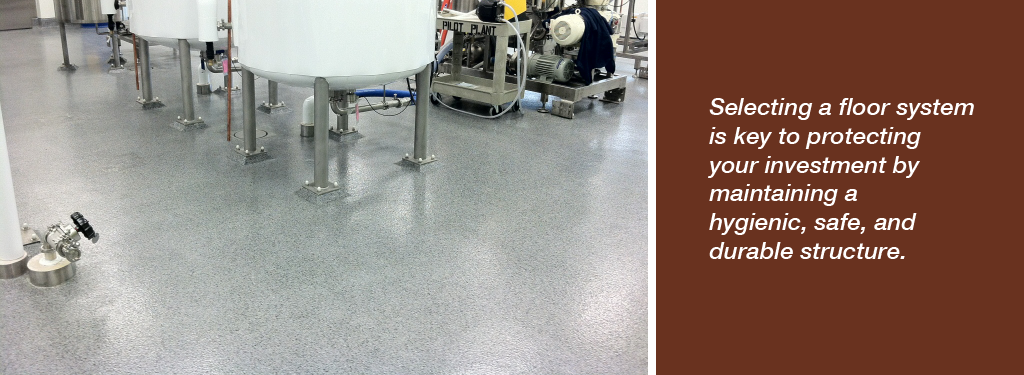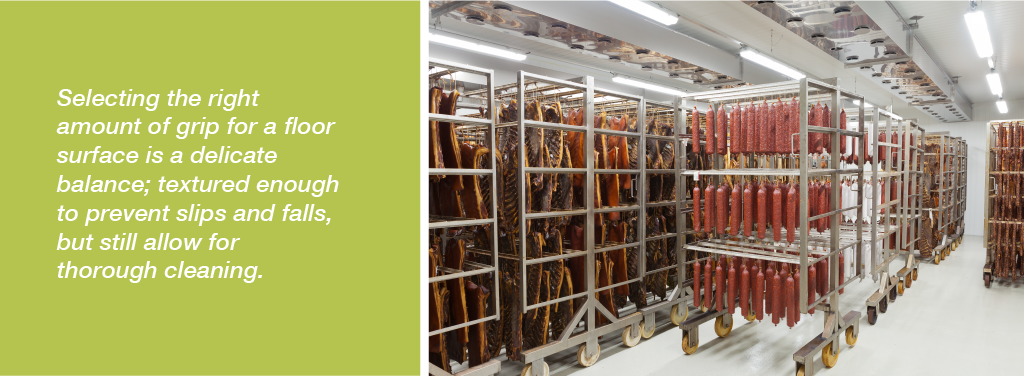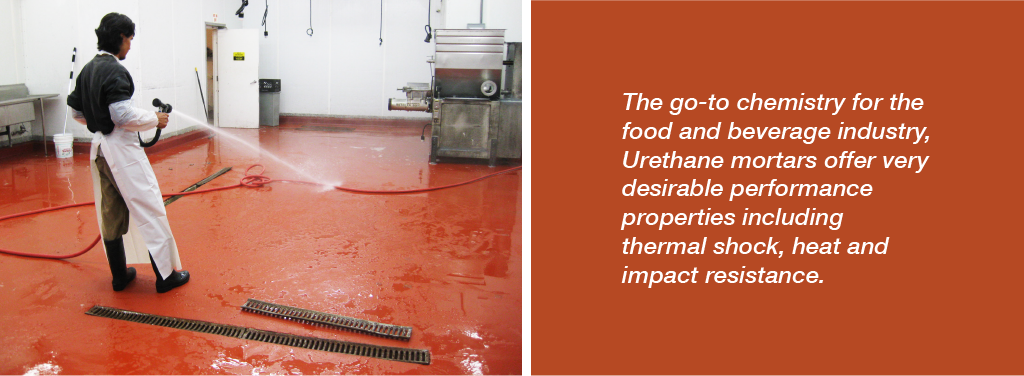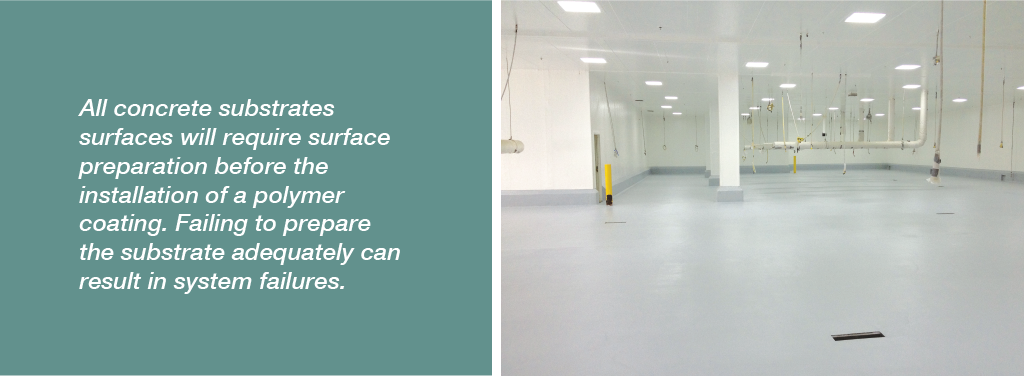Preventing Disastrous Failures in a Food & Beverage Facility

Selecting a floor system in a food and beverage manufacturing facility can be just as important as choosing the materials you put through your facility. Making the wrong decision can lead to costly repairs, employee slip hazards, and even damaging food contamination recalls. The floor is key to protecting your investment by maintaining a hygienic, safe, and durable structure. In this context, we outline the top ten failures that food and beverage facility managers, designers, and contractors can make when selecting and installing the floor.
For more information on how to properly prepare concrete substrates, download APF’s whitepaper on surface preparation here.
Top ten failures
1 – Installing a floor that cannot be cleaned
Cleanliness is of the utmost importance in food and beverage and pharmaceutical facilities. It can be the determining factor for the success or failure of the business. Your floor must not only be able to withstand the pressure and temperature of cleaning practices but must also be able to withstand chemicals utilized in heavy cleaning. Of equal importance, having a monolithic floor surface without seams where mold, mildew, and dangerous bacteria such as listeria can gather results in a more hygienic facility. A flooring system that can withstand rigorous cleaning while preventing harmful bacterial growth can mean the difference between a healthy business and healthy consumers versus costly and damaging recalls and, worst of all, human illness.
APF’s CastorCrete® line is inherently seamless as a poured-in-place polyurethane mortar system. CastorCrete® mortars are industrial grade and non-absorbing, preventing the occurrence of cracks and seams. Additionally, this system offers high resistance to aggressive chemicals often found in sanitizers as well as organic food acids, which can break down the floor and lead to difficulties when cleaning.
2 – Selecting a system with no versatility
No two facilities are the same. Additionally, not all areas of the facility have the same requirements for a flooring system. Options such as thickness, surface finish, and even color should be considered as a food and beverage manufacturing facility is designed.
The CastorCrete system allows designers to select the best product for each facility and budget. Offering light to medium load systems for cafeterias, commercial kitchens, and laboratory areas while providing systems created for heavy load areas, the CastorCrete system offers design flexibility for every project.

3 – Forgetting employee safety
Slip resistance is vital to keeping your employees safe, especially in food and beverage manufacturing locations where oils, fats, and other food products can accumulate on the floor. Slip resistance is an OSHA requirement and essential for the safety and protection of workers. Selecting the right amount of grip for a floor surface is a delicate balance; textured enough to prevent slips and falls, but still allow for thorough cleaning.
When selecting a system for the floor on your project, ensure that the product can be installed to meet environmental health and safety and texture requirements in both wet and dry exposures, ensuring safe working conditions for employees, customers, and visitors in your facility or space.
4 – Assuming that food and beverage facilities are like all other manufacturing facilities
As stated earlier, there are many specific considerations when designing a floor for a food and beverage facility. Researching guidelines and recommendations created by the FDA and USDA for flooring systems is a best practice in this industry. HACCP (Hazard Analysis and Critical Control Point) system is another resource for designers to reference. HACCP is a management system specific to preventing food safety issues and has standards specific to flooring. When selecting a flooring system, ensure that the materials are consistent with these industry recommendations and requirements.

5 – Selecting a ‘wimpy’ floor system
Urethane mortars have become the go-to chemistry for the food and beverage industry. They offer some very desirable performance properties, including impact resistance. Actually, thermal shock, heat and impact resistance are unique to urethane mortar chemistry. Combine all that with the fact they cure very rapidly, and you have the ideal system for the food and beverage industry.
However, some chemistries that have been previously used in this industry have seen mixed results. Most of the failures can be directly related to poor system design and material selection, specifically, the choice of a thin-film coating because of the lower cost. Thin-film coatings will not hold up in most food and beverage processing applications, due to the impact and abrasion these floors are exposed to daily. In general terms, thicker floors last longer.
6 – Skipping the option for antimicrobial
Because process floors in this industry are critical control points to preventing bacteria, why take the risk and select a flooring system that does not have an antimicrobial additive or composition available. Select a flooring system that possesses high thermal shock resistance, the ability to resist animal fats, and harsh chemicals. At the end of the day, having the option of an additional insurance policy to inhibit the growth of bacteria and microorganisms makes sense after making the investment in a new or refurbished facility.
7 – Forgetting the by-products of food manufacturing!
Sure, there are many options when selecting flooring. Narrowing it down to a liquid-applied or poured in place system may lessen your options. However, not all these systems are appropriate in food and beverage manufacturing facilities. Specifically, the use of low-cost, general-purpose resins that do not have the chemical resistance to withstand animal fats, caustic cleaners, and strong acids can cause failures. This is the reason why so many in this industry opt for polyurethane mortars. Polyurethane mortars are by composition inherently resistant to salts, fats, organic acids, sanitizers, and as previously mentioned, other harsh chemicals.

8 – Did someone say “prepare the concrete?”
All concrete substrates surfaces will require surface preparation before the installation of a polymer coating. The very best materials correctly mixed and applied are doomed to fail unless the concrete substrate is properly prepared. Surface prep is crucial. Since most flooring systems used in the food and beverage industry are at least 1/8th inch thick, installers will need to use a shot blaster as the primary prep tool, and a diamond grinder for areas where the other two methods are impractical. There are many more considerations to study because failing to prepare the substrate adequately can result in system failures.
For more information on how to properly prepare concrete substrates, download APF’s whitepaper on surface preparation here.
9 – Ignoring the actual product
In some food manufacturing facilities organic powder dust results from the processing of products like flour, sugar, starch, and cotton for example. In these instances, the use of an ESD static dissipative flooring system is required to prevent the accidental discharge of dangerous electrostatic charges on personnel. When researching flooring options for such facilities, be sure to review the possibilities offered by floor system manufacturers for ESD options. Have a consultative conversation with the manufacturer’s sales representatives to ensure the selection of the safest option for the investment and of course, the welfare of your employees.
10 – Overlooking sustainability
While ‘green’ in construction can refer to many things, including the environmental impact, it can also bring a financial result and impact employee retention. In fact, according to Fast Company, nearly 40% of millennials have chosen a job based on the company’s sustainability program. However often, when selecting construction materials, there is a perception that green or environmentally friendly products must come at a premium cost, and that is not always the case. When selecting a flooring system for any facility, be sure to read the technical documents and data sheets provided by the manufacturer.
Created with renewable resources, APF CastorCrete may provide LEED advantages and marketable benefits for your customers and employees. CastorCrete provides an example of sustainability in construction. Formulated in part with castor oil as 10-20% of the product formulations (formula dependent), which is a renewable resource and contains an ultra-low VOC content*, CastorCrete can be a ‘sustainable’ asset to a facility.
Peters, Adele. “Most Millennials Would Take a Pay Cut to Work at an Environmentally Responsible Company.” Fast Company, 2, February 2019 fastcompany.com/90306556/most-millennials-would-take-a-pay-cut-to-work-at-a-sustainable-company
*VOC measurements have been calculated using ASTM D3960 as specified by SCAQMD Rule 1113.


